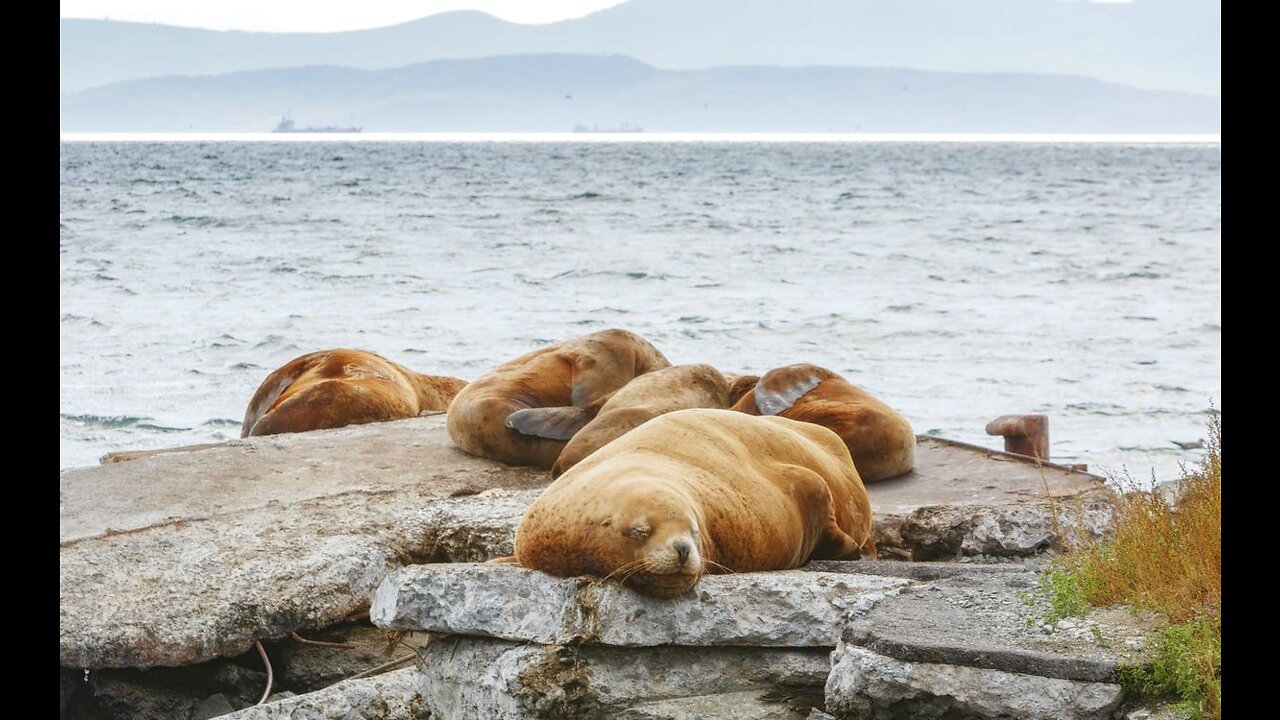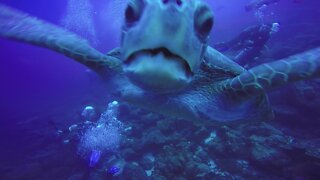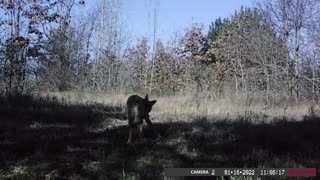Premium Only Content

Curious Sea Lions Swims Front of Camera
Sea lions are pinnipeds characterized by external ear flaps, long foreflippers, the ability to walk on all fours, short, thick hair, and a big chest and belly. Together with the fur seals, they make up the family Otariidae, eared seals, which contains six extant and one extinct species (the Japanese sea lion) in five genera. Their range extends from the subarctic to tropical waters of the global ocean in both the Northern and Southern Hemispheres, with the notable exception of the northern Atlantic Ocean.[1] They have an average lifespan of 20–30 years. A male California sea lion weighs on average about 300 kg (660 lb) and is about 2.4 m (8 ft) long, while the female sea lion weighs 100 kg (220 lb) and is 1.8 m (6 ft) long. The largest sea lion is Steller's sea lion, which can weigh 1,000 kg (2,200 lb) and grow to a length of 3.0 m (10 ft). Sea lions consume large quantities of food at a time and are known to eat about 5–8% of their body weight (about 6.8–15.9 kg (15–35 lb)) at a single feeding. Sea lions can move around 16 knots (30 km/h; 18 mph) in water and at their fastest they can reach a speed of about 30 knots (56 km/h; 35 mph).[2] Three species, the Australian sea lion, the Galápagos sea lion and the New Zealand sea lion, are listed as endangered.[3][4][5]
Contents
1 Taxonomy
2 Physiology
2.1 Diving adaptations
2.2 Parasites and diseases
2.3 Gene expressions and diet
2.4 Geographic variation
3 Breeding and population
3.1 Breeding methods and habits
3.2 Population
4 Interactions with humans
5 Gallery
6 See also
7 References
8 Further reading
Taxonomy
Steller sea lions haul out on a rock off the coast of Raspberry Island (Alaska).
Sea lions are related to walruses and seals. Together with the fur seals, they constitute the family Otariidae, collectively known as eared seals. Until recently, sea lions were grouped under a single subfamily called Otariinae, whereas fur seals were grouped in the subfamily Arcocephalinae. This division was based on the most prominent common feature shared by the fur seals and absent in the sea lions, namely the dense underfur characteristic of the former. Recent genetic evidence, suggests Callorhinus, the genus of the northern fur seal, is more closely related to some sea lion species than to the other fur seal genus, Arctocephalus.[6] Therefore, the fur seal/sea lion subfamily distinction has been eliminated from many taxonomies.
Nonetheless, all fur seals have certain features in common: the fur, generally smaller sizes, farther and longer foraging trips, smaller and more abundant prey items, and greater sexual dimorphism. All sea lions have certain features in common, in particular their coarse, short fur, greater bulk, and larger prey than fur seals. For these reasons, the distinction remains useful. The family Otariidae (Order Carnivora) contains the 14 extant species of fur seals and sea lions. Traditional classification of the family into the subfamilies Arctocephalinae (fur seals) and Otariinae (sea lions) is not supported, with the fur seal Callorhinus ursinus having a basal relationship relative to the rest of the family.[7] This is consistent with the fossil record which suggests that this genus diverged from the line leading to the remaining fur seals and sea lions about 6 million years ago (mya). Similar genetic divergences between the sea lion clades as well as between the major Arctocephalus fur seal clades, suggest that these groups underwent periods of rapid radiation at about the time they diverged from each other. The phylogenetic relationships within the family and the genetic distances among some taxa highlight inconsistencies in the current taxonomic classification of the family.[7]
Arctocephalus is characterized by ancestral character states such as dense underfur and the presence of double rooted cheek teeth and is thus thought to represent the most "primitive" line. It was from this basal line that both the sea lions and the remaining fur seal genus, Callorhinus, are thought to have diverged. The fossil record from the western coast of North America presents evidence for the divergence of Callorhinus about 6 mya, whereas fossils in both California and Japan suggest that sea lions did not diverge until years later.[7]
Suborder Caniformia
Family Otariidae
Subfamily Arctocephalinae
Genus Arctocephalus (southern fur seal; eight species)
Genus Callorhinus (northern fur seal; one species)
Subfamily Otariinae
Genus Eumetopias
Steller's sea lion, E. jubatus
Genus Neophoca
Australian sea lion, N. cinerea
Genus Otaria
South American sea lion, O. flavescens
Genus Phocarctos
New Zealand sea lion or Hooker's sea lion, P. hookeri
Genus Zalophus
California sea lion, Z. californianus
Japanese sea lion, Z. japonicus – extinct (1950s)
Galapagos sea lion, Z. wollebaeki
Family Phocidae: true seals
Family Odobenidae: walrus
-
 0:34
0:34
GalapagosGuys
3 years ago $11.91 earnedCurious sea turtle swims up to camera to take a bite
13.7K43 -
 0:34
0:34
ViralHog
3 years agoCurious Kitty Investigates New Camera
2061 -
 0:42
0:42
Back to Country Homestead
3 years ago $0.01 earnedWild Coyote Plays in Front of Game Camera
321 -
 4:38:41
4:38:41
Viss
8 hours ago🔴LIVE - Taking Wins all Over The PUBG Battleground!
66.8K3 -
 1:44:58
1:44:58
The Quartering
6 hours agoKarmelo Anthony Supporters SWAT Victims Dad, Hatchet Victim Dies, FSU School Shooter Update & More
142K106 -
 55:40
55:40
Tucker Carlson
6 hours agoConor McGregor’s Presidential Bid, Tariffs, Erasing Irish Culture, and Deporting Rosie O’Donnell
106K170 -
 1:02:55
1:02:55
Sean Unpaved
6 hours agoAaron Rodgers' Reflects On The Future, Playoff Showdowns & Ice Battles Begin!
39.2K2 -
 2:02:59
2:02:59
Tim Pool
6 hours agoKarmelo Anthony Debate: Use Of Force & Murder | The Culture War with Tim Pool
158K194 -
 2:08:02
2:08:02
Benny Johnson
8 hours ago🚨BOMBSHELL: New Trump Assassination Plot Revealed! Assassin Would 'Bomb' Trump, Escape to UKRAINE
116K136 -
 1:57:56
1:57:56
Side Scrollers Podcast
7 hours agoBlabs’ Day is RUINED | Side Scrollers
50.1K1